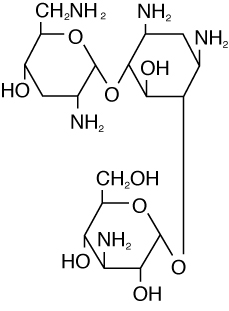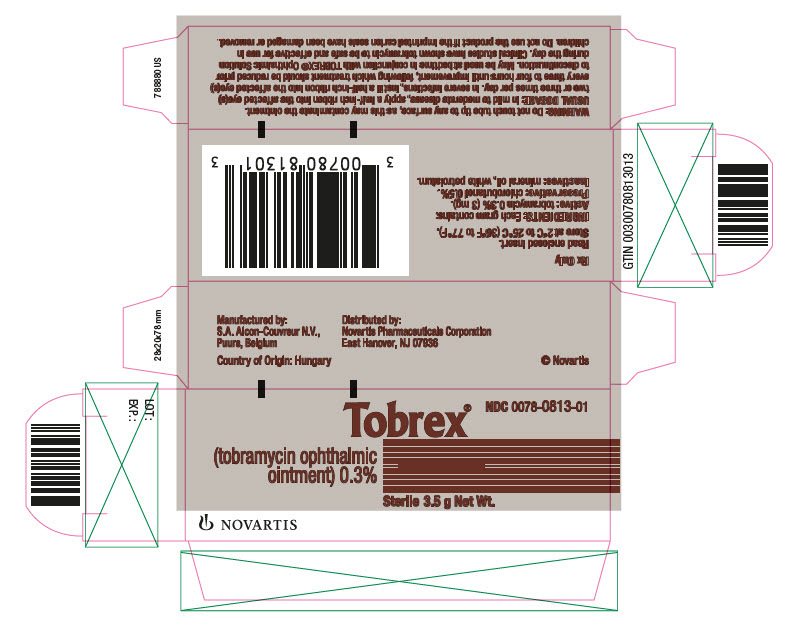TOBREX Dailymed
Generic: tobramycin is used for the treatment of Bone Diseases, Infectious Central Nervous System Infections Pseudomonas Infections Respiratory Tract Infections Skin Diseases, Infectious Staphylococcal Infections Urinary Tract Infections Eye Infections, Bacterial Sepsis Intraabdominal Infections
Go PRO for all pill images
Description
TOBREX® (tobramycin ophthalmic ointment) 0.3% is a sterile topical ophthalmic antibiotic formulation prepared specifically for topical therapy of external ophthalmic infections.
Each gram of TOBREX (tobramycin ophthalmic ointment) 0.3% contains: Active: tobramycin 0.3% (3 mg). Preservative: chlorobutanol 0.5%. Inactives: mineral oil, white petrolatum.
Tobramycin is a water-soluble aminoglycoside antibiotic active against a wide variety of gram-negative and gram-positive ophthalmic pathogens.
The chemical structure of tobramycin is:
Molecular Formula:
C18H37N5O9
Molecular Weight: 467.52 g/mol

Chemical Name:
0-{3-amino-3-deoxy-α-D-gluco-pyranosyl-(1→4) }-0-{2,6-diamino-2,3,6-trideoxy-α-D-ribohexo-pyranosyl-(1→6) }-2-deoxystreptamine.
Clinical Pharmacology
In Vitro Data: In vitro studies have demonstrated tobramycin is active against susceptible strains of the following microorganisms: Staphylococci, including S. aureus and S. epidermidis (coagulase-positive and coagulase-negative), including penicillin-resistant strains.
Streptococci, including some of the Group A-beta-hemolytic species, some nonhemolytic species, and some Streptococcus pneumoniae.
Pseudomonas aeruginosa, Escherichia coli, Klebsiella pneumoniae, Enterobacter aerogenes, Proteus mirabilis, Morganella morganii, most Proteus vulgaris strains, Haemophilus influenzae and H. aegyptius, Moraxella lacunata, Acinetobacter calcoaceticus and some Neisseria species. Bacterial susceptibility studies demonstrate that in some cases, microorganisms resistant to gentamicin retain susceptibility to tobramycin.
Indications And Usage
TOBREX® (tobramycin ophthalmic ointment) 0.3 % is a topical antibiotic indicated in the treatment of external infections of the eye and its adnexa caused by susceptible bacteria. Appropriate monitoring of bacterial response to topical antibiotic therapy should accompany the use of TOBREX (tobramycin ophthalmic ointment) 0.3%. Clinical studies have shown tobramycin to be safe and effective for use in children.
Contraindications
TOBREX (tobramycin ophthalmic ointment) 0.3 % is contraindicated in patients with known hypersensitivity to any of its components.
Warnings
NOT FOR INJECTION INTO THE EYE. Sensitivity to topically applied aminoglycosides may occur in some patients. Severity of hypersensitivity reactions may vary from local effects to generalized reactions such as erythema, itching, urticaria, skin rash, anaphylaxis, anaphylactoid reactions, or bullous reactions. If a sensitivity reaction to TOBREX (tobramycin ophthalmic ointment) 0.3% occurs, discontinue use.
Precautions
General: As with other antibiotic preparations, prolonged use may result in overgrowth of nonsusceptible organisms, including fungi. If superinfection occurs, appropriate therapy should be initiated. Ophthalmic ointments may retard corneal wound healing.
Cross-sensitivity to other aminoglycoside antibiotics may occur; if hypersensitivity develops with this product, discontinue use and institute appropriate therapy.
Patients should be advised not to wear contact lenses if they have signs and symptoms of ocular infections.
INFORMATION FOR PATIENTS SECTION
Information for Patients: Do not touch tube tip to any surface, as this may contaminate the ointment.
Do not use the product if the imprinted carton seals have been damaged, or removed.
PREGNANCY SECTION
Pregnancy: Reproduction studies in three types of animals at doses up to thirty-three times the normal human systemic dose have revealed no evidence of impaired fertility or harm to the fetus due to tobramycin. There are, however, no adequate and well-controlled studies in pregnant women. Because animal studies are not always predictive of human response, this drug should be used during pregnancy only if clearly needed.
NURSING MOTHERS SECTION
Nursing Mothers: Because of the potential for adverse reactions in nursing infants from TOBREX® (tobramycin ophthalmic ointment) 0.3%, a decision should be made whether to discontinue nursing the infant or discontinue the drug, taking into account the importance of the drug to the mother.
PEDIATRIC USE SECTION
Pediatric Use: Safety and effectiveness in pediatric patients below the age of 2 months has not been established.
GERIATRIC USE SECTION
Geriatric Use: No overall clinical differences in safety or effectiveness have been observed between the elderly and other adult patients.
Adverse Reactions Section
ADVERSE REACTIONS: The most frequent adverse reactions to TOBREX (tobramycin ophthalmic ointment) 0.3% are hypersensitivity and localized ocular toxicity, including lid itching and swelling, and conjunctival erythema. These reactions occur in less than three of 100 patients treated with TOBREX® (tobramycin ophthalmic ointment) 0.3%.
POSTMARKETING EXPERIENCE SECTION
Postmarketing Experience: Additional adverse reactions identified from postmarketing use include anaphylactic reaction, Stevens-Johnson syndrome, and erythema multiforme.
The following additional adverse reactions have been reported with systemic aminoglycosides:
Neurotoxicity, ototoxicity and nephrotoxicity have occurred in patients receiving systemic aminoglycoside therapy. Aminoglycosides may aggravate muscle weakness in patients with known or suspected neuromuscular disorders, such as myasthenia gravis or Parkinson’s disease, because of their potential effect on neuromuscular function.
Dosage And Administration
In mild to moderate disease, apply a half-inch ribbon into the affected eye(s) 2 or 3 times per day. In severe infections, instill a half-inch ribbon into the affected eye(s) every 3 to 4 hours until improvement, following which treatment should be reduced prior to discontinuation.
How to Apply TOBREX (tobramycin ophthalmic ointment) 0.3%:
1. Tilt your head back.
2. Place a finger on your cheek just under your eye and gently pull down until a ''V'' pocket is formed between your eyeball and your lower lid.
3. Place a small amount (about ½ inch) of TOBREX® (tobramycin ophthalmic ointment) 0.3% in the ''V'' pocket. Do not let the tip of the tube touch your eye.
4. Look downward before closing your eye.
How Supplied
TOBREX (tobramycin ophthalmic ointment) 0.3% is supplied as a 3.5 g sterile ointment in an aluminum tube with a white polyethylene tip and white polyethylene cap as follows:
3.5 g containing tobramycin 0.3% (3 mg/g).................................................. NDC 0078-0813-01
Storage: Store at 2°C to 25°C (36°F to 77°F).
After opening, TOBREX (tobramycin ophthalmic ointment) 0.3% can be used until the expiration date on the tube.
Distributed by:Novartis Pharmaceuticals CorporationEast Hanover, New Jersey 07936
© Novartis
Revised: June 2021
T2021-76
Principal Display Panel
NDC 0078-0813-01
Tobrex®
(tobramycin ophthalmicointment) 0.3%
Sterile 3.5 g Net Wt.
NOVARTIS

DISCLAIMER:
"This tool does not provide medical advice, and is for informational and educational purposes only, and is not a substitute for professional medical advice, treatment or diagnosis. Call your doctor to receive medical advice. If you think you may have a medical emergency, please dial 911."
"Do not rely on openFDA to make decisions regarding medical care. While we make every effort to ensure that data is accurate, you should assume all results are unvalidated. We may limit or otherwise restrict your access to the API in line with our Terms of Service."
"This product uses publicly available data from the U.S. National Library of Medicine (NLM), National Institutes of Health, Department of Health and Human Services; NLM is not responsible for the product and does not endorse or recommend this or any other product."
PillSync may earn a commission via links on our site

